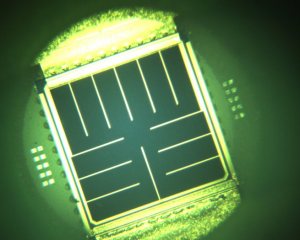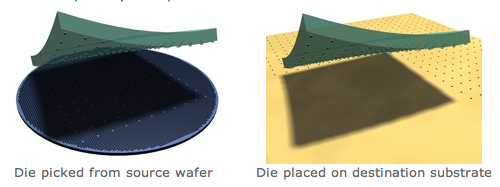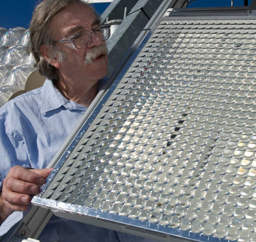Dutham, North Carolina-based startup Semprius has taken the transfer-printing technology it originally developed for flexible electronics and applied it to solar cells. Now what's coming out of the lab? Sheets of tiny solar cells -- each small cell the size of a ballpoint pen tip -- and able to convert 41 percent of solar energy into electricity using low-cost lenses to concentrate the sun more than 1,000 times. Those high numbers were recently validated by the DOE's National Renewable Energy Laboratory (NREL) in tests that showed one of the highest efficiencies recorded at that concentration (see NREL graphic showing 30 years of increasing solar efficiency). The new technology, a quick spin-out from the University of Illinois nanoelectronics and biophotonics research group, headed by John Rogers, has made a quick trip to commercialization. Watch an overview video about his university lab, above.
Road to commercialization
First Semprius received seed money from the DOE; later it was thrown together with the experts at the NREL-based SunShot Incubator Program; and after millions in construction grants, it manufactured its technology using its patented micro-transfer printing process. Semprius has already broken ground (watch annoucement ceremony) on a manufacturing plant in Henderson, N.C., which should be up and running next year.
Departure from traditional silicon

Semprius' signature triple-junction cells are made of gallium arsenide. Their tiny size means they occupy only one-one thousandth of the entire solar module area, reducing the module cost and helps to distribute unwanted heat over the cell's structure. These high efficiency gallium arsenide-based microcells, measuring only 600 microns by 600 microns in area and less than 10 microns thick, are up to 300 times smaller than cells used by competing HCPV manufacturers. Semprius engineers use the company's patented micro-transfer printing process (short CGI demo) to allow the micro-cells to be transferred from the growth substrate to a wafer. The crucial first step is the fabrication of a reusable stamp, which eliminates the need to recreate subwavelength features from scratch every time the metamaterial is fabricated. In a massive parallel process, thousands of cells are transferred simultaneously. This allows the original substrate to be used again and again, dramatically cutting costs. It also provides a way to handle very small cells. Additional layers are automatically added to the wafer so that a very efficient, triple-junction solar cell is constructed.

Siemens investment validated new technology
The modules that will be manufactured in the North Carolina plant starting next year will be 24 inches by 18 inches, and about 2 and a half inches deep. They will have a concentration of more than 1,100 suns and an efficiency of more than 31 percent. These modules would be cost competitive with fossil fuel technology at high volume.

This low-cost approach, which Semprius executives say can cut manufacturing expense by 50 percent, attracted energy giant Siemens this year, which took a 16 percent stake in the young company. The two companies have a significant link, with Semprius' CEO Joe Carr previously president and CEO of Siemens subsidiary Osram Opto Semiconductors, according to Optics.Org. In a statement announcing the Siemens investment, Carr said that Siemens' presence as a strategic investor would come at a crucial time, as Semprius looks to scale up its production capability. "Their far-reaching presence and strength in the renewable market offers us an immediate global footprint," he added. Siemens and Semprius have actually been working together for the past 18 months. According to the two companies, Semprius' first full test installation (press release) has been operating in Tucson, Arizona, since August 2010, combining Semprius' CPV modules with an automated 2-axis solar tracking system developed by Siemens. The tracker, designed to operate in Arizona's arid desert climate, uses NREL's Solar Positioning Algorithm, which provides a tracking accuracy of better than 0.2 degrees. The tracker also features built-in remote data acquisition capability that allows Semprius to monitor the performance of the system. "Our technology's extremely small footprint and high efficiency play a key role in minimizing HCPV system cost and improving performance and reliability," said Joe Carr, President and CEO of Semprius. "By collaborating with Siemens and Tucson Electric Power, we believe this demonstration will represent a continuing effort to drive down the cost of solar power." Although the market for CPV systems remains only a tiny fraction of the wider PV sector right now, analysts have predicted a 1 GW annual market to emerge by 2015, while Siemens says that it expects CPV to become a 6 GW market by the end of the decade.



